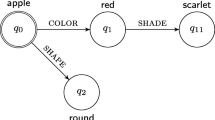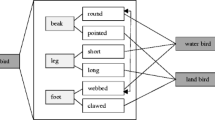Abstract
The first part of the paper proposes a formal foundation of a theory of frames. Frames are embedded into a general ontology. On this background, we introduce a formal model-theoretic semantics for frames and thereby an interface to formal semantics. The model-theoretic semantics allows us to define central notions of frame theory such as the “satisfaction type” for a node in a given frame, and a semantic definition of subsumption. The second part presents a case study of decomposition: frames for subtypes of intransitive punctual verbs of change, such as punctual ‘grow’ and ‘go from A to B’. We introduce times, events, and time-dependent attributes in the ontology. A crucial element of the analysis is “comparators”, a novel type of attribute in frame theory. Comparators are partial two-place attributes that compare two individuals of the same sort and return comparison values such as ‘=’ vs. ‘≠’ or ‘<’ vs. ‘=’ vs. ‘>’. Comparators allow us to model within frames and AVMs conditions in terms of basic abstract relations. The approach proposed offers simplifications of alternative proposals for the frame-theoretical decomposition of these types of verb: (i) standard PL1 is used as a frame description language; (ii) with comparators, the use of non-functional relations as additional components in frames can be avoided; (iii) meanings of punctual verbs of change can be represented within one frame.
Access this chapter
Tax calculation will be finalised at checkout
Purchases are for personal use only
Similar content being viewed by others
Notes
- 1.
For the sake of simplicity, the fact is ignored that it is not the whole eyes that are specified for color, but rather the iris. The complex aspects of color predication are not at issue here.
- 2.
The frame around the number is omitted when the label is written into a frame diagram node.
- 3.
- 4.
We will make use of an implicitly presupposed ontology when we discuss examples below. To come up with a concrete definition of a frame ontology for semantic analysis is a task for semantic and ontological theory for decades of research.
- 5.
Barsalou ([4]: 601) uses comparators (although not called so) in his model of truth and falsity for propositions. Comparators check whether an internal simulation [roughly, a frame] can be “map[ped] successfully into a perceived scene”. Truth and falsity is envisaged in our approach as a further application of comparators, probably of second order and hence outside the scope of frame theory sketched here.
- 6.
These comparators are first-order in that they compare individuals.
- 7.
See Löbner [11], Chap. 6, for a basic outline of the theory of tense and aspect supposed here.
- 8.
Note that \( \mathfrak{F}_{\mathbf{PunCh}} \) is not a frame structure in accordance with Definition 1 as it contains the attribute variables ‘attr’ and ‘© s,Rel ’; \( \mathfrak{F}_{\mathbf{PunCh}} \) is a frame schema.
- 9.
See Dowty [6]: 88ff for the notion of degree achievement verb.
- 10.
The notion ‘progressive’ is to be taken in the functional, semantic sense, as relating to a certain variant of imperfective aspect, not in the morphological sense.
- 11.
See Martin [13], p. 518 for the punctuality of the Japanese verbs mentioned here and below.
- 12.
ik- is the bare stem of the verb, not inflected for tense. The citation form of Japanese verbs carries the present tense ending -u or -ru.
References
Allen, J.F.: Maintaining knowledge about temporal intervals. Commun. ACM 26, 832–843 (1983)
Barsalou, L.W.: Cognitive Psychology: An Overview for Cognitive Scientists. Lawrence Erlbaum Associate, Hillsdale (1992)
Barsalou, L.W.: Frames, concepts, and conceptual fields. In: Lehrer, A., Kittay, E.F. (eds.) Frames, Fields, and Contrasts: New Essays in Semantic and Lexical Organization, pp. 21–74. Lawrence Erlbaum Associate, Hillsdale (1992)
Barsalou, L.W.: Perceptual symbol systems. Behav. Brain Sci. 22, 577–660 (1999)
Carpenter, B.: The Logic of Typed Feature Structures. Cambridge University Press, Cambridge (1992)
Dowty, D.R.: Word Meaning and Montague Grammar. Reidel, Dordrecht (1979)
Gamerschlag, T., Geuder, W., Petersen, W.: Glück auf, der Steiger kommt: a frame account of extensional and intensional steigen. In: Gerland, D., Horn, C., Latrouite, A., Ortmann, A. (eds.) Meaning and Grammar of Nouns and Verbs, Studies in Language and Cognition, vol. 1, pp. 115–144. Düsseldorf University Press, Düsseldorf (2014). http://dup.oa.hhu.de/517/
Kallmeyer, L., Osswald, R.: Syntax-driven semantic frame composition in lexicalized tree adjoining grammars. J. Lang. Model. 1, 267–330 (2013)
Löbner, S.: Evidence for frames from human language. In: Gamerschlag, T., Gerland, D., Osswald, R., Petersen, W. (eds.) Frames and Concept Types, Studies in Linguistics and Philosophy, vol. 94, pp. 23–67. Springer, Heidelberg (2014)
Löbner, S.: Functional concepts and frames. In: Gamerschlag, T., Gerland, D., Osswald, R., Petersen, W. (eds.) Meaning, Frames, and Conceptual Representation. Studies in Language and Cognition, vol. 2, pp. 13–42. Düsseldorf University Press, Düsseldorf (2015). http://dup.oa.hhu.de/1/
Löbner, S.: Understanding Semantics, 2nd edn. Routledge, London and New York (2013)
Löbner, S.: Polarity in natural language: predication, quantification, and negation in particular and characterizing sentences. Linguist. Philos. 23, 213–308 (2000)
Martin, S.E.: A Reference Grammar of Japanese. Yale University Press, New Haven and London (1975)
Muller, P.: Topological spatio-temporal reasoning and representation. Comput. Intell. 18, 420–450 (2002)
Naumann, R.: An outline of a dynamic theory of frames. In: Bezhanishvili, G., Löbner, S., Marra, V., Richter, F. (eds.) TbiLLC 2011. LNCS, vol. 7758, pp. 115–137. Springer, Heidelberg (2013). doi:10.1007/978-3-642-36976-6_9
Petersen, W.: Representation of concepts as frames. In: Skilters, J. et al. (eds.) Complex Cognition and Qualitative Science. The Baltic International Yearbook of Cognition, Logic and Communication, vol. 2, pp. 151–170. University of Latvia, Riga (2007)
Roberts, W.A., Coughlin, R., Roberts, S.: Pigeons flexibly time or count on cue. Psychol. Sci. 11, 218–222 (2000)
Varzi, A.C.: Parts, wholes, and part-whole relations: the prospects of mereotopology. Data Knowl. Eng. 20, 259–286 (1996)
Acknowledgments
The theory presented here arose from joint work at Düsseldorf University in the Research Unit RU 600 ‘Functional Concepts and Frames’ (2005–2011), continued in the Collaborative Research Centre CRC 991 ‘The Structure of Representations in Language, Cognition, and Science’ (2011–2019 or later), both financed by the German Science Foundation; see http://www.sfb991.uni-duesseldorf.de/en/ for the CRC. The author profited tremendously from extended discussion with Ralf Naumann, Wiebke Petersen, Henk Zeevat, and Timm Lichte. Reference to Roberts et al. [17] is owed to Tobias Kalenscher; Christopher Habel referred the author to the work on mereotopology mentioned above.
Author information
Authors and Affiliations
Corresponding author
Editor information
Editors and Affiliations
Rights and permissions
Copyright information
© 2017 Springer-Verlag GmbH Germany
About this paper
Cite this paper
Löbner, S. (2017). Frame Theory with First-Order Comparators: Modeling the Lexical Meaning of Punctual Verbs of Change with Frames. In: Hansen, H., Murray, S., Sadrzadeh, M., Zeevat, H. (eds) Logic, Language, and Computation. TbiLLC 2015. Lecture Notes in Computer Science(), vol 10148. Springer, Berlin, Heidelberg. https://doi.org/10.1007/978-3-662-54332-0_7
Download citation
DOI: https://doi.org/10.1007/978-3-662-54332-0_7
Published:
Publisher Name: Springer, Berlin, Heidelberg
Print ISBN: 978-3-662-54331-3
Online ISBN: 978-3-662-54332-0
eBook Packages: Computer ScienceComputer Science (R0)




